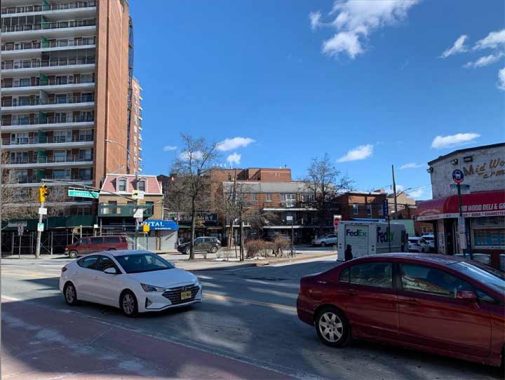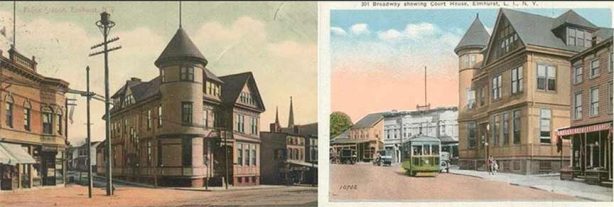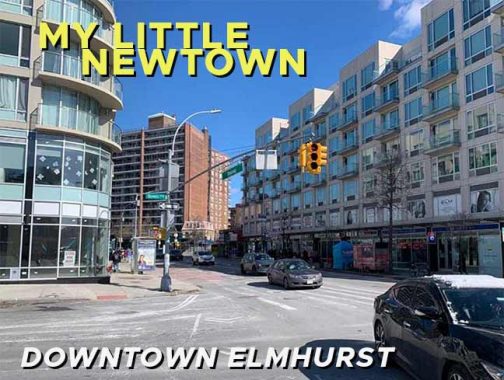
It’s that time of the month again…when I want a weekend off, that is. I’m handing it off to Sergey again for a visit to Elmhurst, or rather, its predecessor…
By SERGEY KADINSKY
Forgotten New York correspondent
AMONG the former towns of Queens that were absorbed into Greater New York in 1898, Newtown is the least remembered. The postal system left it out of the zip code prefixes, the neighborhood’s name was changed to Elmhurst, and its Town Hall was unceremoniously demolished. Only a .02-acre triangle and the street behind it serve as reminders of its past municipal independence.

Libra Triangle and Justice Avenue speak of this spot as a former courthouse, police precinct, and Town Hall. Neighborhoods within the former towns of Long Island City, Flushing and Jamaica have their own zip code prefixes, 110-, 113- ,and 114- respectively. But within the former Town of Newtown, there is no central post office and its neighborhoods have the same -113 prefix as the former town of Flushing.

As Flushing Town Hall and Jamaica Town Hall served as the administrative centers of those respective towns, the Newtown Courthouse was a center of local government. According to James Riker’s “The Annals of Newtown, in Queens County,” the building was completed in 1849, replacing an earlier Town Hall built in 1803.
After Newtown was downgraded to a city neighborhood and renamed Elmhurst, the former town seat served as a municipal courthouse and as a police precinct until 1940, when the 110th Precinct received a new stationhouse on 43rd Avenue. In 1943, the borough’s Topographical Bureau proposed the removal of the former Town Hall and reducing the size of the triangular property to accommodate traffic.
Following Newtown Town Hall’s demolition in 1966, Justice Avenue was widened with a traffic triangle at Broadway. Under former Park’s Commissioner Henry J. Stern, the site was named Libra Triangle in the early 1990s.
Looking south on Broadway from Justice Avenue toward Queens Boulevard. This section of Broadway was once separate from the one in Long Island City; there were finally fully connected when the IND Subway was constructed in the 1930s.
Another place where one can see evidence of the former town seat is at the local public library, which has a map from 1906 on display. The map has other notable tidbits: parallel dotted lines snaking through the block that was the course of Horse Brook; Newtown Presbyterian Church that was relocated across Queens Boulevard in the 1930s to accommodate the subway line; and a small cemetery that was deconsecrated in the 1950s for an apartment building.
This library was one of a dozen financed by Andrew Carnegie in the early 20th century but as it became crowded, a decision was made to demolish it in favor of a larger postmodern structure. To see a landmarked Carnegie library in Queens, visit the branch at Richmond Hill, or the Poppenhusen library in College Point. In honor of the great philanthropist, the first floor reading area carries his name.
The demolition of the original Elmhurst library was controversial, and it explains the blueprint image of the old building behind the circulation desk, the use of light yellow bricks, and ample outdoor space around the new building. The blend of history and postmodernism is also felt from the staircase inside from which one can see the landmarked Old Saint James Parish Hall constructed in 1735 give or take a year.
The block of Broadway between Queens Boulevard and Justice Avenue was the center of the former town seat, a downtown or an “old city” if it can be described as such. This is where Newtown was founded in 1652, a decade after an earlier settlement at Maspeth was destroyed by the Natives. Besides the landmarked Newtown High School, the subway station underneath this block also remembers the former municipality in its name.
Failing to recognize the historical value of this block, its old buildings were gradually replaced in the past century by simple I do not know if Newtown had an emblem, but at the high school’s main entrance is a mosaic that looks like an official seal. Not all of Queens’ old municipalities had official emblems. One example, that of Long Island City, is used as the logo of Greater Astoria Historical Society, a longtime partner of Forgotten-NY.
Failing to recognize the historical value of this block, its old buildings were gradually replaced in the past century by simple brick storefronts, with one exception.. 86-01 Justice Avenue is a dental office whose mansard roof and gabled windows date to the 19th century. Back in 1940 when the city conducted its photographic tax survey, the tenant here was Court Pharmacy, named for the courthouse across the street.
In the past decade, mixed-use high-rises have transformed a block of single story small shops into a wall of cream-colored rentals with glass balconies. In this 1980 tax survey photo, the pharmacy-turned-convenience store is in the shadow of the Grandview Towers co-op.
I do not expect that mansard house on Justice Avenue to outlive me. A couple of blocks to the east on Justice Avenue there was a similar structure from the 1800s at 90-11 56th Avenue that stood until a fire gutted it in Sept. 2015. Two months later, I visited this home with my infant daughter to pay our respects. It was demolished shortly afterward for an uninspiring row of boring brick boxes.
Near the former town seat is a more recent example of period architecture that will soon face demolition. The clinic at 86-15 Queens Boulevard that appears in the AIA Guide to New York City for its cubist modernism will become a seven-story building. Wherever there is a gas station, diner, parking lot, there is an opportunity for a high-rise. That’s the story of Queens Boulevard in Elmhurst.
Additional examples of former municipal seats within NYC documented by Forgotten-NY include the former town halls of Gravesend and New Utrecht, the village of New Brighton, and the town hall of Flatbush.
Highlights from FNY’s Elmhurst/Newtown tour in 2011
Sergey Kadinsky is the author of Hidden Waters of New York City: A History and Guide to 101 Forgotten Lakes, Ponds, Creeks, and Streams in the Five Boroughs (2016, Countryman Press) and the webmaster of Hidden Waters Blog.
As always, “comment…as you see fit.” I earn a small payment when you click on any ad on the site.
2/20/22
